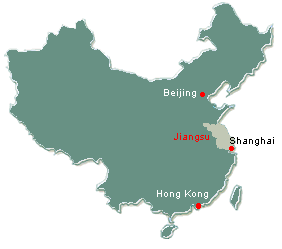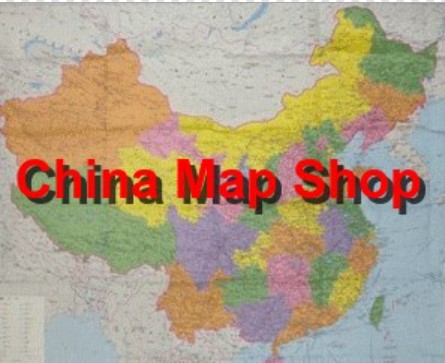|
|
|
Geography of Jiangsu Province |
|
Jiangsu
province is situated in the east of China on the lower
reaches of the Yangtze River, bordering the Huanghai Sea and
covering a coastline of over 1,000 kilometers. With a total
area of over 102,600 square kilometers and a population of
74.28 million, it is the most density populated province in
China. Its population consists of
Han,
Manchu and other
nationalities and its capital is
Nanjing. |
|
|
Climate of Jiangsu Province |
Situated in
a transitional zone between temperate zone and subtropical
zone, Jiangsu has a temperate climate, moderate rainfall,
and four distinct seasons. In most part of the province the
average temperature of January, the coldest month, is
between
0°C
and 4°C
(32°F
and 39.2°F),
while a temperature between
-1°C
and 2°C
(30.2°F
and 35.6°F),
in Xuzhou district; the average temperature of July, the
warmest month, gradually increases southwards from 26°C
to 28°C
(78.8°F
and 82.4°F).
The average annual precipitation rises from 800mm to 1,200mm
in a northwest-southeast direction. In summer, with the
coming of southeast monsoon, Jiangsu has plenty of rain. The
precipitation drops less in winter. Jiangsu has plenty of
“plum rain” when spring is changing into summer and typhoon
rain around summer and autumn.
|
|
|
Brief History of Jiangsu Province |
Jiangsu used
to be part of State of Wu in the Spring and Autumn Period
(770-467 B.C) and after changes of dynasties became Jiangsu
Province in the sixth year of Emperor Kangxi’s reign (1667
A.D) in the Qing Dyansty. It has remained so until today.
Over a century ago, Jiangsu was the political and economic
centre of the Taiping Heavenly Kingdom when the struggle
against imperialism and feudalism was launched around
Tianjing (today’s Nanjing). During the Revolution of 1911
led by Dr. Sun Yat-sen which ended in the prolonged feudal
rule in China, the Provisional Government of the New
Republic was established in Nanjing.
|
|
|
Jiangsu Local Products |
Situated in
the middle and lower reaches of the Yangtze River, Jiangsu
province has numerous lakes, easy access to transportation,
rich resource and a great variety of special local products.
Jiangsu is well known for whitebait from Taihu Lake, hilsa
herring and wolf herring from the Yangtze River, big crabs
from Yangcheng Lake, Nanjing pressed salted duck, duck’s egg
with double yolks from Gaoyou, Langshan chicken from
Nantong, pig from Taixing, Biluochun Tea, Yanghe Daqu
Liquor, Shuanggou Daqu Liquor, sweet peach from Taihu Lake
and other products. One of the four famous styles of
embroidery in China, Suzhou embroidery is reputed as “pearl
of art in the East”. It is characterized by fine
workmanship, lively needlework, and exquisite designs and
elegant colour. Brocade is known for its simple and bold
design, rich and bright colour, simple style and sturdy
quality. It was mainly used for making royal costumes in
ancient China and now sells well in international market.
Pottery and porcelain from Yixing, clay sculpture from Wuxi
and lacquer ware from Yangzhou all enjoy national and
international fame.
|
|
|
Jiangsu Local Cuisine |
Known as a
land of fish and rice in China, Jiangsu Province has a rich
variety of ingredients available of cooking. Huaiyang
Cuisine characterized by strict selection ingredients,
meticulous preparation and proper use of fire is
representative of Jiangsu Cuisine. The main dishes are
stewed pork meat patties, and broken bone fish’s head, etc.
Suzhou, Wuxi and Nanjing are also famous for their local
delicacies. There are many restaurants serving local choice
food in various parts of Jiangsu. Touring Jiangsu Province,
one may both feast his eyes on the scenery and have a good
taste of renowned local food.
|
|
|
Places of Interests and Tourist Attractions in Jiangsu |
|
There are ten cities
in Jiangsu Province that are open to foreign tourists, namely,
Nanjing, Suzhou, Wuxi, Zhengjing, Yangzhou, Changzhou, Yixing,
Xuzhou, Lianyun Harbour and Huai’an. With many places of historic
interest and scenic attractions, many of these cities have a history
of over 2,000 years, some even over 5,000 years. Nanjing, Suzhou and
Yangzhou are nationally renowned for their historical and cultural
heritage; Nanjing’s Zhongshan Hill and
Wuxi’s Taihu Lake are among
the first group of tourist areas designated by the state.
Representing the best classic architectural art of gardens in south
China, Suzhou’s gardens stand as the proof of the wisdom and
creativity of Chinese working people. Image of Moya of the Han
Dynasty in Kangwang Mountain, Lianyun Harbour is among China’s
earliest stone carvings, which attracts numerous visitors, both
Chinese and foreign. The urban wooded hills in Zhenjiang, caves and
sea of bamboo in Yixing, plain scenery in Huai’an and the emerging
industry in Changzhou all appeal to tourists with their own unique
features. Jiangsu has much to tourists in terms of entertainment,
such as sailing along the Ancient Canal, highway sightseeing,
cycling, walking tours, making a study of Buddhist culture and
gardens, cooking lesions, honeymoon trip, fishing, convalescence
program and practice of shadow boxing. All these items are welcome
by overseas tourists.
With a total length of 1,794 kilometres, the Ancient Canal, one of
two grand ancient Chinese engineering projects, starts from Tangzhou
in Beijing and ends in Hangzhou, Zhejiang Province, linking up south
China with north China. Construction of the Canal started 2,400
years ago and was completed at the end of 6th century. Like the
Great Wall, the Ancient Canal is a symbol of China’s ancient
civilization. Many sections of the Canal are still navigable today.
Sailing along the canal, one not only feast his eyes on the scenery
of the world famous canal, but can also learn something about
people’s life and local customs on both sides of the canal. The
Ancient Canal passes a number of cities with famous scenic
attractions, such as Suzhou, Wuxi, Changzhou and Yangzhou, etc.
Travelling along the Ancient Canal can be a fascinating experience
to tourists.
|
|
|
|
|
|
Jiangsu Useful Links and Sites
|
|
|
|
|
Major
Cities in Jiangsu Province |
|
|
|
|
Jiangsu
Related Report and Article Links
|
|
|
|
|
|
|
|
|
|
|



